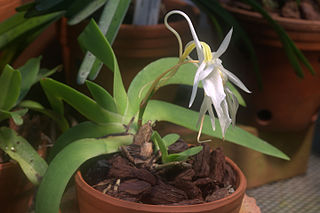
Angraecum, also known as comet orchid, is a genus of the family Orchidaceae native to tropical and South Africa, as well as Sri Lanka. It contains 223 species.

Pseudovanilla, commonly known as giant climbing orchids, is a genus of eight climbing orchids in the family Orchidaceae. Orchids in this genus have tall climbing stems with clinging roots, leaf-like bracts and branching flowering stems with colourful, spreading sepals and petals. Species in the genus are native to Indonesia, the Philippines, New Guinea, Australia, Solomons, Micronesia and Fiji.

Phalaenopsis micholitzii is a species of plant in the family Orchidaceae. It is endemic to the Zamboanga peninsula in the island of Mindanao, Philippines.

Didymoplexis, commonly known as crystal orchids or as 双唇兰属 , is a genus of terrestrial leafless orchids in the family Orchidaceae, about twenty species of which have been described. Orchids in this genus have swollen, fleshy rhizomes and thin, pale, upright fleshy flowering stems with resupinate, bell-shaped white or pale yellowish brown flowers. They are native to Africa, Madagascar, Southeast Asia, Australia and various islands of the Pacific.

Amesiella philippinensis is a species of orchid endemic to the Island of Luzon in the Philippines. Like Vanda falcata it was mistaken as an Angraecum species, due to the white, long-spurred flowers. The plant produces rounded leaces up to 5 cm in length. Three or four white, fragrant flowers of 3 cm in width are produced on short inflorescences. The labellum is yellow in the throat. It occurs at lower altitudes than Amesiella monticola and has a shorter spur.

Trichoglottis, commonly known as cherub orchids or 毛舌兰属 , is a genus of flowering plants in the family Orchidaceae. Orchids in this genus are epiphytic plants with thick roots, relatively thick, fibrous stems and many large, thick, leathery leaves arranged in two ranks. The flowers are usually small and yellowish with light brown or purple markings. The flowers have broad sepals, narrower petals and a labellum which has three lobes and is often hairy. There are about 85 species distributed from tropical and subtropical Asia to the north-western Pacific. Most species grow in rainforest.

Angraecum eburneum is a species of orchid. Their common name the "comet orchid". They generally grow up to 2 metres in height and grows 10 to 15 flowers per plant. They are native to Madagascar, Comoros, Seychelles, Réunion, Mauritius, Kenya, and Tanzania. It is the national flower of Seychelles.

Angraecum leonis is a species of flowering plant in the family Orchidaceae.

Robiquetia succisa, commonly known as The Abruptly Broken Off Robiquetia, is a small to medium-sized species of pouched orchid found from eastern Nepal to southern China and Indochina.
Bulbophyllum lichenoides is a species of orchid in the genus Bulbophyllum. This plant is non-poisonous. It is found in New Guinea on trees in range forests at elevations around 800 meters as a mini-miniature sized, warm growing epiphyte with barely noticeable, cylindrical pseudobulbs carrying a single, apical, patent, oblong, obtuse leaf that blooms in the late winter and early spring on an erect, short to 0.12" (3 mm) long, single flowered inflorescence.

Elleanthus is a genus of flowering plants from the orchid family, Orchidaceae. They are commonly known as tiger orchid. All the species are native to the warmer parts of the Western Hemisphere.
Systeloglossum is a genus of flowering plants from the orchid family, Orchidaceae. It contains 5 known species, all native to southeastern Central America and northwestern South America.
- Systeloglossum acuminatumAmes & C.Schweinf. - Costa Rica, Panama
- Systeloglossum bennettii(Garay) Dressler & N.H.Williams - Peru
- Systeloglossum costaricenseSchltr. - Peru
- Systeloglossum ecuadorense(Garay) Dressler & N.H.Williams - Ecuador
- Systeloglossum panamenseDressler & N.H.Williams - Panama

Micropera utriculosa is a species of orchid in the genus Micropera first described by Oakes Ames in 1915 under the name Camarotis utriculosa. It is endemic to the Philippines.
Leslie Andrew Garay, born Garay László András, was an American botanist. He was the curator of the Oakes Ames Orchid Herbarium at Harvard University, where he succeeded Charles Schweinfurth in 1958. In 1957 he was awarded a Guggenheim Fellowship.

Aa maderoi is a species of orchid in the genus Aa. It is native to Ecuador, Colombia, and Venezuela. Its' common name is Madero's Aa.

Trichoglottis atropurpurea, the dark purple trichoglottis, is a species of orchid endemic to the Philippines. This hot to warm growing epiphyte was first found growing in mangrove swamps in the islands of Biliran, Catanduanes, Mindanao and Polillo. The plant shares the same appearance with T. philippinensis except for the rich dark color of the blooms and slight variation of the perianth. This species was first described in 1877 by the German botanist Heinrich Gustav Reichenbach, an expert on the orchid family. At that time, thousands of newly discovered orchids were being sent back to Europe, and he was responsible for identifying, describing and classifying many of these new discoveries.

Trachoma, commonly known as spectral orchids, is a genus of flowering plants in the family Orchidaceae. Orchids in this genus are epiphytic plants with leafy stems, crowded, leathery leaves arranged in two ranks and a large number of relatively small, short-lived flowers that often open in successive clusters. The sepals and petals are free from and more or less similar to each other, except that the petals are often smaller. The labellum is rigidly fixed to the column and is more or less sac-shaped. There are about 17 species distributed from Assam to the Western Pacific Ocean. Most species grow in rainforests, often on emergent trees such as hoop pine.
Acianthera antennata is a species of orchid native to Brazil.

Amesiella monticola is a miniature species of epiphytic orchid native to the Philippines. The specific epithet "monticola" refers to the montaneous habitat of the species. Monticola is a combination of "mons" or "montis", meaning mountain and "cola" or "colere" meaning "inhabitant" or "dweller".

Amesiella minor is the smallest species of the genus Amesiella. These miniature epiphytic orchids are native to the Philippines.




















